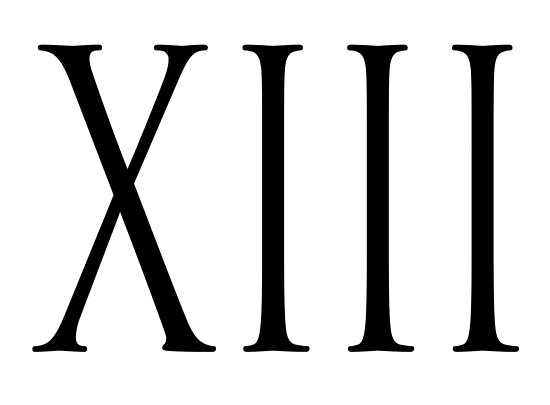Xiii Roman Numerals
The chord progression vi–ii–V–I in the key of C major. Using lead sheet chord names, these chords could be referred to as A minor, D minor, G major and C major.Roman numeral analysis is a type of in which are represented by (I, II, III, IV, ). In some cases, Roman numerals denote themselves.
XIII may refer to: 13 (number) or XIII in Roman numerals; 13th century in Roman numerals; XIII (comics), a Belgian comic book series by Jean Van Hamme. January 13, 2020 Printed in Roman numerals, great for tattoos, date reminders, anniversary events, and birthdays. Darksiders genesis.
More commonly, however, they represent the chord whose is that scale degree. For instance, III denotes either the third scale degree or, more commonly, the chord built on it. Typically, uppercase Roman numerals (such as I, IV, V) are used to represent major chords, while lowercase Roman numerals (such as i, iv, v) are used to represent minor chords (see and below for alternative notations). However, some use upper-case Roman numerals for all chords, regardless of.In Western in the 2000s, music students and theorists use Roman numeral analysis to analyze the of a. In, and and, Roman numerals can be used to notate the of a song independent of key. For instance, the standard progression uses the chords I (first), IV (fourth), V (fifth), sometimes written I 7, IV 7, V 7, since they are often. In the key of C major, the first scale degree is C, the fourth is F, and the fifth is a G.
So the I 7, IV 7, and V 7 chords are C 7, F 7, and G 7. On the other hand, in the key of A major, the I 7, IV 7, and V 7 chords would be A 7, D 7, and E 7. Roman numerals thus abstract chord progressions, making them independent of key, so they can easily be. See also:In related to or derived from the, Roman numerals are frequently used to designate as well as the chords built on them.
In some contexts, however, with are used to designate the scale degrees themselves (e.g., ).The basic Roman numeral analysis symbols commonly used in pedagogical texts are shown in the table below. SymbolMeaningExamplesUppercase Roman numeralILowercase Roman numeraliSuperscript +I +Superscript oi oSuperscript numberAdded noteV 7Two or more numbers( #-#)V 4–3Superscript # and ##I 6I 64The Roman numerals for the seven diatonic triads built on the notes of the C major scale are shown below. In addition, according to Music: In Theory and Practice, 'sometimes it is necessary to indicate sharps, flats, or naturals above the bass note.' The accidentals may be below the superscript and subscript number(s), before the superscript and subscript number(s), or using a slash (/) or plus sign (+) to indicate that the interval is raised (either ♮ in a flat key signature or a ♯ or in a sharp key signature.are indicated with a slash e.g. V/V.Modern Schenkerians often prefer the usage of large capital numbers for all degrees in all modes, in conformity with Schenker's own usage.


Roman numeral analysis by Heinrich Schenker (1906) of the degrees ( Stufen) in bars 13–15 of the Allegro assai of J. Bach's Sonata in C major for violin solo, BWV 1005.
Inversions Roman numerals are sometimes complemented by Arabic numerals to denote inversion of the chords. The system is similar to that of, the Arabic numerals describing the characteristic interval(s) above the bass note of the chord, the figures 3 and 5 usually being omitted.
The first inversion is denoted by the numeral 6 (e.g. I 6 for the first inversion of the tonic triad), even although a complete figuring should require 63; the numerals 64 denotes the second inversion (eg I 64).
Inverted seventh chords are similarly denoted by one or two Arabic numerals describing the most characteristic intervals, namely the interval of a second between the 7th and the root: V 7 is the dominant 7th (e.g. G–B–D–F); V 65 is its first inversion (B–D– F–G); V 43 its second inversion (D– F–G–B); and V 42 or V 2 its third inversion ( F–G–B–D). Jazz and pop numerals.